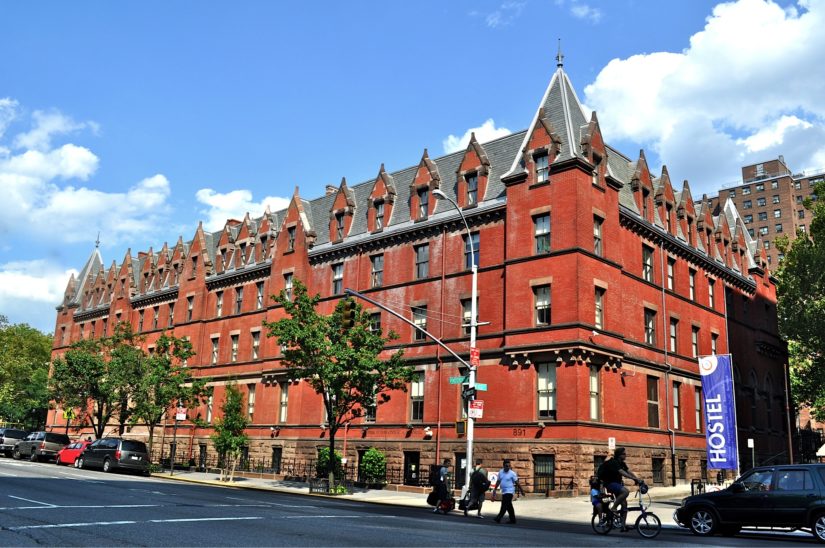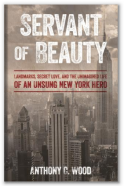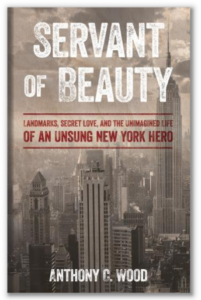
Association Residence for Respectable Aged Indigent Females
Association Residence for Respectable Aged Indigent Females, a philanthropic war building built in 1883, saved from demolition in the 1970s by a lively preservation effort led by graduate students from a renowned university in the City, now housing the Hostelling International New York City.
The Association Residence for Respectable Aged Indigent Females was commissioned by one of New York City’s earliest charitable institutions, the Association Residence for the Relief of Respectable Aged Indigent Females.[1] The Residence, a Victorian Gothic brick building built in 1883, was designed by the prominent architect Richard Morris Hunt. The style of the Residence, while sometimes called Victorian Gothic, has an overtly French rather than English influence, in keeping with Hunt’s French training and preferences.[2]
The building was constructed initially on the corner of Amsterdam Avenue and West 104th Street. Later additions by the Architect Charles A. Rich in 1907 extended the structure to West 103rd Street. The Residence operated until 1965 when the interiors were remodeled and the building renamed the Association Residence Nursing Home (or the Association Residence for Women).[3] In 1974, the remainder of the residents were relocated to a separate facility to permit plans for the demolition and erection of a new structure to proceed. Those plans were later aborted, however, as the building was designated in the National Register of Historic Places in February of 1975. It remained vacant for several years, losing much of its original slate roof in a fire in July of 1977. In 1978, the property was acquired by the municipal government and allotted funds for the roof’s repair.[4]
In 1983, the Landmarks Preservation Commission unanimously designated the Association Residence as an individual landmark in a public hearing. The recognition and awareness from the involvement of various academic, community, and preservation organizations catalyzed efforts to rehabilitate the building through adaptive reuse. In 1987, New York City’s Economic Development Corporation partnered with Valley Restoration Local Development Corporation and a private developer called Syebedon Corporation to find funding and rehabilitate the structure to house an international hostel. In 1990, the building opened its doors under the new ownership of American Youth hostels and was subsequently called Hostelling International USA.
[1] https://hdc.org/buildings/association-residence-for-respectable-aged-indigent-females/, “Association Residence for Respectable Aged Indigent Females”, Historic Districts Council, accessed on September 14, 2022
[2] http://s-media.nyc.gov/agencies/lpc/lp/1280.pdf, “Association Residence for Respectable Aged Indigent Females,” Landmark Designation Report, NYC Landmarks Preservation Commission, April 12, 1983
[3] http://s-media.nyc.gov/agencies/lpc/lp/1280.pdf, “Association Residence for Respectable Aged Indigent Females,” Landmark Designation Report, NYC Landmarks Preservation Commission, April 12, 1983
[4] https://placematters.net/census/detail.php?id=320, Hostelling International New York, Place Matters, June 2011
Records, 1813-1882.
Association for the Relief of Respectable Aged and Indigent Females in New York City.
New-York Historical Society
Mss Collection (BV Association for the Relief of Respectable Aged Non-circulating )
https://bobcat.library.nyu.edu/permalink/f/22u4kq/nyu_aleph001451974
1883 Association Residence for Respectable Aged Indigent Female, the building was completed designed by Richard Morris Hunt
1907 Association Residence was expanded to include additional rooms and a chapel
1949 Association Board Chair, Mrs. Cox, quoted in The New York Times as having to “save the building” from Robert Moses’s efforts that replaced many buildings during the West Side’s Urban Renewal years, including the construction of Frederick Douglass Houses close to 891 Amsterdam.
1965 Interior Renovation of the Association Residence to modernize living spaces
1974 The building was abandoned and fell into disrepair
1975 Association Residence listed on the National Register of Historic Places
1975-76 City of New York threatens demolition unless funds are found to tin-seal the structure
1977 Parts of the building burned down in the Blackout
1978 Building foreclosed and acquired by the City of New York
1983 Designated as a city landmark by the New York City Landmarks Preservation Commission
1987 Rehabilitation of the building begins
1990 Building reopened as the Hostelling International USA
Individual Landmark Designation by New York Landmarks Commission in 1983
Landmark listed in the National Register of Historic Places in 1975
In the early 1800s, a group of socially prominent women incorporated an organization to care for disadvantaged women, primarily the war widows and aged female relatives of men who died in the Revolutionary War and the War of 1812. These women in need of care were often unable to support themselves given the gender restrictions in places of work and commerce at the time. The Association for the Relief of Respectable Aged and Indigent Females formed in 1814, and by 1833 it was operating at 266 East 20th Street.[1] Women were admitted by showing proof of their respectability, a donation of $50, and by renouncing the ownership of any estate they may own to the Association.[2]
As the Association outgrew its limited facilities, plans were made to construct a new building. Reportedly in 1843, the Association purchased land along the Fourth (now Park) Avenue between East 78th and 79th Street, later discarding the location in favor of twenty reasonably-priced lots at Tenth Avenue (later called Amsterdam Avenue) between West 103rd and 104th streets.[3] Architect Charles Meltam was appointed as the first architect for the new Association Residence in 1870.[4] However, shortly after the construction began, the Association faced several difficulties in terms of building permits and soon had to halt the operations due to insufficient funds. [5]
In 1880, a second attempt began to build the Association Residence. The following year, Richard Morris Hunt, an architect famous for his French-inspired residences commissioned by affluent families like the Vanderbilts, was hired as the architect.[6] The Residence was designed as a rectilinear C-shaped plan containing 85 rooms along single bays, with asymmetrical wings- the north shorter than the south to accommodate a semi-octagonal single-story extension at its east end.[7] Completed in 1883, the Association Residence for Respectable Aged Indigent Females includes load-bearing masonry walls clad with red bricks rising three full stories, complementing yet distinct from the rock-faced brownstone ashlar basement and the slate-covered mansard roof. In 1902, a wide areaway lined with ornate wrought-iron railing was added along the building. [8]
In 1907, with a philanthropic donation from Mrs. Russell Sage, the Association extended the Residence southward to West 103rd Street, providing an additional thirty rooms and a larger chapel. The extension was designed by the Architect Charles A. Rich of Rich, Mathesius, and Koyl. The celebrated window of the Chapel was donated by Tiffany Co., was since removed, and is currently housed in a museum in Winter Park, Florida.[9]
In the 1960s, the Association began facing acute financial challenges. In 1965, the board planned to convert the Residence into a nursing home to receive Medicaid assistance and invest in remodeling the structure to meet new sanitary requirements.[10] This led to an interior renovation that included the transformation of 65 victorian-size closets into baths.[11] However, in 1974, the aging structure failed to meet the fire safety codes and plans were soon put forward to demolish the building and replace it with a modern nursing home.[12]
The winds began to shift in 1974 when a group of students in the Historic Preservation Program at the School of Architecture at Columbia University studied the history of the Association Residence, and, upon finding out that the Association Board was considering demolition, began efforts to rally support to save the building.[13] The application for the listing on the National Register of Historic Places, prepared in November 1974, was successfully listed the following February and soon became an important factor in the preservation effort.[14] Given the successful designation in the National Register, the Association with the help of Columbia Law students, filed a lawsuit to prevent demolition of the building on legal grounds that federal funds could not be used to pay for or the demolition of a building on the National Register.[15] The Architectural League, the Natural Resources Defense Council, the office of Congressman Charles Rangel, and others acted as co-plaintiffs with the Association in the lawsuit.
The lawsuit slowed down the process and the Association ran out of money. In the fall of 1974, the remaining women residents were moved out to a separate facility in the Bronx. Soon, the site became vandalized and endured the theft of copper pipes and other valuable materials. It attracting drug addicts and squatters. In 1975, the City of New York ordered the building’s demolition as a “fire, health and moral hazard.” The City charged the Association for the demolition, costing around $300,000. During the July 1977 Blackout, the building was set ablaze, the entire roof and two upper level flooring systems were destroyed, and the rest of the building was sealed off. The City then took over the site.
However, the unrelenting group of Historic Preservation students and the Association Board members met with City officials, and convinced them to withdraw the demolition effort contingent on the building being tin-sealed on the first two floors. The funding was found through the efforts of Manhattan Borough President Ruth Messinger. Simultaneously, architect Robert A.M. Stern nominated the historic building for designation as an individual landmark with the New York Landmarks Preservation Commission, and local residents supported the efforts to rehabilitate the structure. Suggestions were put forward to use the building for community groups or as a supplementary City Hall. Due to the community’s continued efforts, in 1983, the City’s Landmarks Preservation Commission voted to convey city landmark status to 891 Amsterdam.
A long process then commenced to find a new use for the building. American Youth Hostels had entered the picture in the late 1970s as it worked with City officials to find a location for a youth hostel in New York City. The proposal to use 891 Amsterdam Avenue as a youth hostel emerged and the City’s Economic Development Corporation teamed American Youth Hostels with Valley Restoration Local Development Corporation to see if the building could work as a hostel. By 1987, plans were in place. A private developer, Sybedon Corporation, was brought into the process to handle financing and construction management, with a contract with American Youth Hostels to manage the building - and to eventually become its owner after ten years.[16]
American Youth Hostels, later changing its name to Hostelling International USA, opened the building as a youth hostel in January 1990. The replacement of the slate mansard roof along with the existing flat membrane roof was carried out by CTA Architects. As a part of this project, which won the Landmark West! Unsung Heroes of the Upper West Side Preservation Award in 2011, the significantly deteriorated brick and stone masonry was rebuilt and restored, existing fireproof dormer roof framing and decking were replaced, and the cast stone and metal finials were installed based on historic documentation.[17]
[1] https://theclio.com/entry/82706, “Association for the Relief of Respectable Aged and Indigent Females (1814); Hostelling International”, Woodham R., Clio: Your Guide to History, June 30, 2019
[2] https://www.upperwestsidehistory.org/blogs/the-story-of-891-amsterdam-avenue-and-how-it-became-a-new-york-city-landmark, The Story of 891 Amsterdam Avenue and How It Became a New York City Landmark, Tice P., October 28, 2013
http://www.columbia.edu/~hauben/RNA-House/history/session23-text.pdf, The Story of 891 Amsterdam Avenue and how it became a New York City Landmark, Tice P., October 22, 2018
[3] https://placematters.net/census/detail.php?id=320, Hostelling International New York, Place Matters, June 2011
[4] Advisory Committee minutes, 1867-1882, Association for the Relief of Respectable Aged and Indigent Females in New York City, New-York Historical Society- Mss Collection (BV Association for the Relief of Respectable Aged Non-circulating ), 1813-1882 (visited on November 18, 2022)
[5] Ibid.
[6] Ibid.
[7] http://s-media.nyc.gov/agencies/lpc/lp/1280.pdf, “Association Residence for Respectable Aged Indigent Females,” Landmark Designation Report, NYC Landmarks Preservation Commission, April 12, 1983
[8] http://s-media.nyc.gov/agencies/lpc/lp/1280.pdf, “Association Residence for Respectable Aged Indigent Females,” Landmark Designation Report, NYC Landmarks Preservation Commission, April 12, 1983
[9] http://westsiderambler.com/blog/2016/5/3/the-association-residence-for-the-respectable-aged-indigent-females-aka-the-american-youth-hostel, “The Association Residence for the Respectable Aged Indigent Females aka The American Youth Hostel”, Westside Rambler, May 03, 2016
[10] https://placematters.net/census/detail.php?id=320, Hostelling International New York, Place Matters, June 2011
[11] https://timesmachine.nytimes.com/timesmachine/1970/01/25/91177603.pdf?pdf_redirect=true&ip=0, Huxtable, Ada Louise, “This is Silver Lining Day,” The New York Times, January 25, 1970.
[12] https://www.nytimes.com/1974/06/19/archives/a-visible-anchor-to-past-would-be-lost-in-razing.html, Goldberger P., The New York Times, June 19, 1974.
[13]https://catalog.archives.gov/id/75319271, “National Register of Historic Places–Nomination Form,” National Archives and Records Administration, February 19, 1975
[14] Ibid.
[15] https://www.ecfr.gov/current/title-36/chapter-I/part-60, “PART 60 - NATIONAL REGISTER OF HISTORIC PLACES,” Code of Federal Regulations, November 16, 1981
[16] https://www.nytimes.com/1988/03/27/realestate/west-side-landmark-to-become-a-hostel.html?searchResultPosition=1, Lyons R., “West Side Landmark to Become A Hostel”, The New York Times, March 27, 1988.
[17] https://www.ctaarchitects.com/american-youth-hostel-page, “American Youth Hostel- Exterior Preservation”, CTA Architects, Visited on September 21, 2022




